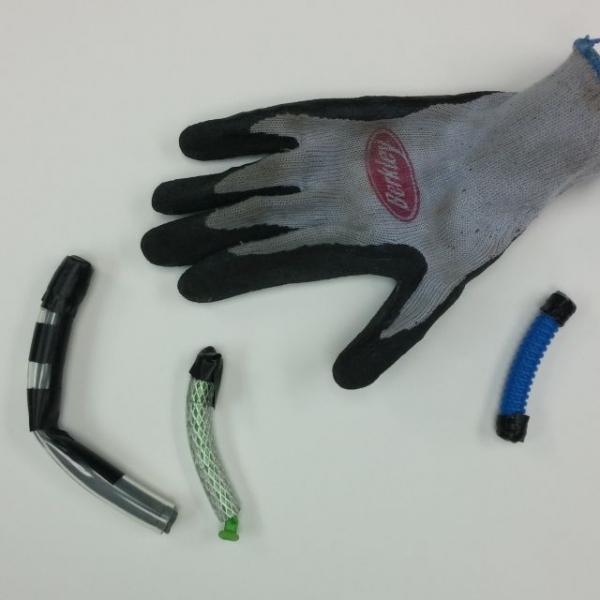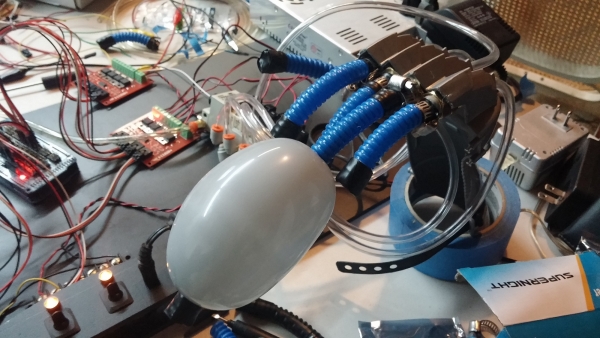Testing and Performance
The robotic hand was not designed to meet a specific set of requirements or capabilities. Rather, the idea was to create a soft robotics project that would be accessible to a wider audience. Performance of the soft robotic hand has been acceptable, based on the goals of the project.
- Keep the project low cost
- Use easily available materials
- Use techniques that most hobbyists would find not too difficult
The resulting design was published in the May issue of Popular Science.
The video below demonstrates the hand and control board operation.
The following subsections will discuss performance observations of the individual actuators, the hand as a whole, and the control board.
Actuator Testing and Performance
The video excerpt below is from Erin Kennedy's February 2015 Robot Party, where I discuss the reliability of the finger actuators. The Robot Party is an online community of robot makers who share their projects and discuss robotics ideas.
Materials
As mentioned in the design section, several different materials for the fingers were tried. The ribbed hose selected for the prototype worked the best. However, it is far from perfect. The fingers do fail after repeated use. Others are encouraged to investigate other materials and techniques.

Reliability
Sometimes the tip of the finger blows out, as shown in the picture below, or it fails along the length. These failures are caused when the plastic fatigues and one of the cuts in the finger splits beyond the stress relief holes.

Potential Modifications
A 3D printed design to replace the ribbed hose is an interesting option. The growth of 3D printing has made a custom designed actuator a reasonable possibility for a hobbyist. The ability to manipulate design parameters and rapidly prototype for increased reliability is very attractive.
This project will be updated if a workable solution using 3D printing can be developed.
Hand Testing and Performance
The video below is an excerpt from Erin Kennedy's February 2015 Robot Party. The Robot Party is an online community of robot makers who share their projects and discuss robotics ideas. In the video I demonstrate the manual and programmed modes of operation, and discuss the performance of the gripper.
Gripper Performance
As a practical gripper, the hand has very limited use. The fixed position of the fingers makes it much less flexible than a human hand, while the soft materials make it much less precise than a traditional robotic gripper. In effect... the worst of both worlds!
The hand can hold light objects like a ball or a light weight hand tool. It could be attached to a larger robot arm as an end effector, and used in situations where precision and grip strength are not as important as having a gentle, compliant grip.
Gesture Performance
Much of human communication is non-verbal. By using gestures that humans are familiar with, a robot can elicit an emotional response. For example, different responses from an observer are likely if the robot is gently waggling its fingers, taping impatiently, imitating a rude gesture, or ominously counting down.
Programmed Mode
In programmed mode, the several gestural positions and programmed motions can be amusing, and are instructive as an example of what soft robotics can do. Additional positions and motions can be programmed as well.
Manual Mode
When operating in manual mode, the frequency of the Pulse Width Modulation (PWM) used to control the air valves can be changed via a potentiometer. The frequencies used are in the audio range and sound is emitted by the coils of the air valves during use. The frequency also visibly alters the movement of the fingers from a stuttering motion to a fairly smooth motion.
Within the limits of the freedom of motion, the hand can be made to "dance" and "sing" along to the control of an operator, which can be somewhat entertaining.
Control Board Testing and Performance
The video below is an excerpt from Erin Kennedy's February 2015 Robot Party. The Robot Party is an online community of robot makers who share their projects and discuss robotics ideas. In the video I demonstrate the control board, and also discuss how this project can be a jumping off point for people interested in using the soft robotics toolkit.
The control board performed very well. As mentioned in the design section, there are certain differences between the prototype and the fluidic control board design defined on the main Soft Robotics Toolkit.
- Pressure sensors were eliminated to reduce cost.
- An 8-valve manifold was used to leave room for future expansion.
- Instead of an on-board compressor, an off-board workshop air compressor supplies the necessary pressurized air.
- Power is provided by one 12V DC and one 24V DC supply.
- A sensor shield (daughter board) was used with the microcontroller to make electrical connections easier.
- Five potentiometers (one for each finger) provide manual control over each actuator.
- One potentiometer allows you to vary the Pulse Width Modulation (PWM) frequency used to control the flow of air to the actuators.
- A toggle switch allows you to either select manual control with the five potentiometers, or programmed control.
- A 12-position rotary switch lets you select between twelve different hand positions and gestures.
- Choice of black for the color is much cooler.
User Interface
The controls knobs and switches are all located on the outer edges of the board so they are easy to reach. As I built the prototype for myself, nothing is labeled. I did find that when I invited others to use it, the controls were fairly intuitive. Even children quickly learned how to operate the hand.
Expandability
The use of an 8-port manifold allows for controlling more pneumatic actuators. Actuators could be added to move control a robotic arm or to add additional degrees of freedom to the existing hand.
Because the current control panel is fully populated, it may have to be replaced or modified if additional actuator control is desired.
The programmable nature of the Arduino Mega microcontroller allows for plenty of software expandability.